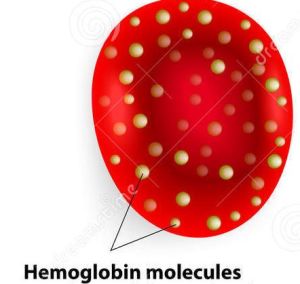

MedFriendly®


Hemoglobin
Hemoglobin (abbreviated Hb) is a red substance (made
of iron and protein) in the blood that carries oxygen to
the cells in the body from the lungs. Hemoglobin also
carries carbon dioxide away from the cells to the lungs,
which is then exhaled from the body. Carbon dioxide is
a colorless and odorless gas that is present in small
amounts in the air and is produced as a result of
metabolism in the body. Metabolism is the chemical
actions in cells that release energy from nutrients or
use energy to create other substances.
FEATURED BOOK: Mosby's Diagnostic and Laboratory Test Reference
Each red blood cell contains 200-300 molecules of hemoglobin. Red blood cells help
carry oxygen in the blood due to the presence of hemoglobin. A molecule is a
combination of atoms. An atom is the smallest part of a substance that can exist alone or
in combination with something else. Hemoglobin is often analyzed along with hematocrit,
which is known as H&H. Hematocrit is the percentage of the amount of blood that is
occupied by red blood cells that are packed together. Red blood cells help carry oxygen
in the blood. Each molecule of hemoglobin contains 4 groups of heme. Heme is the iron
component of hemoglobin. Each group of heme can carry one molecule of oxygen. A
hemoglobin molecule also contains 4 globin polypeptide chains composed of amino
acids. Amino acids are a group of chemical substances that form proteins. Globin is a
type of protein. A polypeptide chain is simply a long chain of amino acids. Overall, each
hemoglobin molecule consists of about 3.8% heme and 96.2% globin.
"Where Medical Information is Easy to Understand"™
Each polypeptide chain is made of 141 to 146
amino acids. When one of these amino acids is
removed, added, or replaced by another amino
acid, it changes in chemical structure. Different
types of hemoglobin are identified by their specific
combinations of polypeptide chains. The most
common hemoblobin types are alpha and beta
hemoglobin, while delta and gamma hemoglobin
are less common. Hemoglobin contains 4 types of
polypeptide chains. There are two polypeptide
chains (known as alpha globin chains) that contain
141 amino acid residues.

There are other chains that contain 146 amino acids. The production of each type of polypeptide chain is
controlled by a gene with a similar Greek letter. Genes are units of material contained in a person's cells
that contain coded instructions as for how certain bodily characteristics (such as eye color) will develop.
WHAT ABOUT OXYHEMOGLOBIN< CARBOXYHEMOGLOBIN, AND METHHEMOGLOBIN?
In an atmosphere in the body with a normal concentration of oxygen (such as the lungs), hemoglobin
combines with oxygen to form oxyhemoglobin. Oxyhemoglobin brings oxygen from the lungs to the
tissues. When the oxygen is released, oxyhemoglobin changes back to hemoglobin.
In an atmosphere in the body with low oxygen concentration (such as peripheral tissues of the body),
exposure to certain chemicals cause oxygen to be replaced with carbon dioxide, a stable substance.
The combination of carbon dioxide and hemoglobin is known as carboxyhemoglobin. Hemoglobin
releases carboxyhemoglobin in the lungs (which is exhaled) and picks up more oxygen to bring to the
cells. When people inhale exhaust fumes from gasoline engines, the chemicals from the fumes displace
oxygen from oxyhemoglobin and cause the formation and buildup of carboxyhemoglobin. The buildup of
this chemical can lead to suffocation.
Methhemoglobin is a substance formed when the iron in hemoglobin is oxidized (loses an electron). An
electron is a negatively charged particle that is smaller than an atom. Methemoglobin cannot carry
oxygen, which makes it a dangerous substance. It is typically formed in response to certain chemicals,
such as nitrates (a form of nitrogen, a type of natural element).
HOW MANY TYPES OF HEMOGLOBIN ARE THERE?
Several hundred types of hemoglobins have been identified and classified with different abilities to move
through liquid in response to changes in an electric field. Examples of hemoglobin types include C, D, E,
G, H, I, J, K, L, M, N, O, and S. The reason there are so many types of hemoglobin is because amino
acids can easily substitute for another type of amino acid in the polypeptide chain. Whenever this
happens, a new type of hemoglobin is formed. Some types of hemoglobin are abnormal not because one
or more amino acids were substituted, but because it has been completely deleted.
In humans, there are 5 types of normal hemoglobin, meaning that other types of hemoglobin are
abnormal. Two types of normal hemoglobin are present in embryos: Hb Gower-1 and Hb Gower-2. An
embryo is a fertilized egg from the time of conception until the 8th week of pregnancy. Normal
hemoglobin in the fetus is known as Hb F. A fetus is a developing human that is inside the mother from
the end of the 8th week to birth. There are 2 normal types of hemoglobin in adults, known as Hb A and Hb
A2.
The clinical significance of abnormal types of hemoglobin is mostly unknown, but the significance of
some is known. There may be many more types of hemoglobin yet to be discovered. When a new type
of hemoglobin is discovered, it is first assigned a name, usually named after the location where it was
discovered. Then a formula is determined to list the types of molecules that make up the new type of
hemoglobin.
The formula consists of Greek letters to designate the basic polypeptide chains. If there are two identical
polypeptide chains, then the subscript 2 is added to the formula. Sometimes a superscript letter may be
added to the formula. For example, the superscript A means that it is hemoglobin A, a normal type of
hemoglobin. Sometimes, there may be a superscript number, which is used to designate where along the
polypeptide chain an abnormal substitution occurred. So if the superscript 121 was present, this would
mean the abnormal substitution occurred at the 121st chain. The nature of the substitution would be
described next to the number in superscript as well. Hundreds of different types of hemoglobin are
detailed at the Online Mendelian Inheritance in Man Project.
WHAT IS THE NORMAL LEVEL OF HEMOGLOBIN?
The normal level of hemoglobin is 12 to 16 g/dL in women and 13.5 to 18 g/dL in men. g/dL stands for
grams per deciliter. A gram is a very small unit of weight. You would need about 453 grams just to get
one pound. A deciliter is one tenth of a liter.
WHAT CAN CAUSE HEMOGLOBIN TO BE TOO HIGH?
If hemoglobin is too high this can mean there is congenital heart disease, which is heart disease one is
born with. High hemoglobin levels can be due to increased red blood cell formation associated with too
much erythropoietin (a type of hormone that stimulates the production of red blood cells). Hormones are
natural chemicals produced by the body and released into the blood that have a specific effect on
tissues in the body.
High hemoglobin levels can be caused by polycythemia vera. Polycythemia vera is a condition of
unknown cause in which there is a long-term increase in red blood cells and other types of cells. High
hemoglobin levels can be caused by pulmonary fibrosis, which is the formation of scar tissue in the
connective tissue of the lungs. High hemoglobin levels can also be caused by cor pulmonale, which is
enlargement of the heartís right ventricle cause by lung disease. The right ventricle is an opening in the
heart that pumps out blood with the low level of oxygen to the lungs.
WHAT CAN CAUSE HEMOGLOBIN TO BE TOO LOW?
Hemoglobin can be too low because of lead poisoning, bleeding, poor nutrition (not enough nutrients
such as iron, folate, vitamin B-12, or vitamin B-6), too little erythropoietin (see prior section) due to
kidney disease. Other causes include overhydration (too much water in the body) and red blood cell
destruction associated with a bad reaction to a blood transfusion. A disease that is defined by too little
hemoglobin in the blood is known as anemia. There are various types of anemia.
WHAT IS MEAN CORPUSCULAR HEMOGLOBIN?
Mean corpuscular hemoglobin concentration (abbreviated as MCHC) is an estimate of the concentration
(amount) of hemoglobin in a given number of packed red blood cells.
WHAT IS THE MOLECULAR WEIGHT OF HEMOGLOBIN?
The molecular weight of hemoglobin is 64,450. The molecular weight is how much the molecule weighs.
WHY IS IT CALLED HEMOGLOBIN?
Hemoglobin comes from the Greek word "haima" meaning "blood," and the Latin word "globus" meaning
"ball." Put the words together and you have "blood ball."















